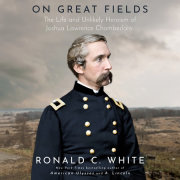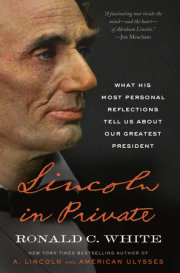Formation, 1828 to 1855
One“Do It! That’s How!”
A boy’s will is the wind’s will,
And the thoughts of youth are long, long thoughts.—Henry Wadsworth Longfellow, “My Lost Youth,” 1855
On a warm August day in Maine, a young boy plods across his family’s farmland, leading two oxen drawing a wagon heavily loaded with hay. Suddenly the wagon pitches, one wheel stuck between two tree stumps. It cannot move forward.
“Clear the wheel!” his father, walking behind the wagon, commands.
“How am I going to do it?” the boy replies.
“Do it! That’s how!” the father booms.
The son grips the hub of the lodged wheel and shoves and shoves with all his young might. Finally, to his astonishment, the cart tongue bumps against the off ox, and the wagon lurches ahead.
Years later, Joshua Lawrence Chamberlain would often recall this challenge, his father’s impossible command, and his own surprise and relief upon success. “ ‘Do it! That’s how!’ was a maxim whose value far exceeded the occasion,” Chamberlain would recall in a memoir of his boyhood. It became for him “an order for life”—an instruction for how to face any obstacle.
Chamberlain was the first child of Joshua Chamberlain, Jr., and Sarah Dupee Brastow. Born on September 8, 1828, during the final months of John Quincy Adams’s presidency, his life started on his family’s one-hundred-acre farm in Maine, set at the edge of the Penobscot River next to the village of Brewer in the “Down East” or eastern coastal part of the state. The Chamberlain house, average in size for that time, stands today at 350 North Maine Street.
Upon their son’s birth, Joshua and Sarah inscribed his name as Lawrence Joshua Chamberlain in their large family Bible. Underneath they wrote, “named for Commodore Lawrence of the American Navy.”
Captain James Lawrence, commander of the USS Chesapeake, a thirty-eight-gun wooden-hulled three-masted frigate, fought the British HMS Shannon off the New England coast during the War of 1812. Although Lawrence suffered mortal wounds in a losing naval battle, he would be remembered as an American hero for his defiant final order: “Don’t give up the ship.” The boy’s parents, ardent patriots, wished to honor Lawrence’s courage in their naming.
With their son’s name, his parents, in good Puritan tradition, also tethered his identity to the biblical Joshua. Chamberlain recalled that his parents admired how the biblical Joshua “left nothing undone which the Lord had commanded.” The boy would be the third Joshua in five generations of American Chamberlains.
Chamberlain’s family name traced its origins back to the twelfth century, when ancestor Richard de Tankerville became a chamberlain—the officer in charge of managing a royal household—to England’s King Stephen.
The first American Chamberlain, William, emigrated from Hingham, a market town in the east of England, to Massachusetts in 1648. Abraham Lincoln’s ancestor Samuel Lincoln had left this same town for a new England eleven years earlier. Both became part of “the Great Migration” of hundreds of ships and thousands of people who set their sights on the New World and the opportunities they hoped to find there. Over the next century and a half, the first generations of American Chamberlains worked long and hard to make a living as farmers in the stony land of far northern Massachusetts.
In 1799, Lawrence’s grandfather Joshua moved his family to Orrington. Joshua, Jr., was born there the next year. Chamberlain’s father grew up in a new nation energized by the spirit of the American Revolution.
On young Lawrence’s mother’s side, Jean Dupuis, a Huguenot from La Rochelle, France, was an ancestor revered for his steadfast faith. French Catholics first used “Huguenot” as a term of derision for French Protestants as the Reformation, sparked by John Calvin, spread across France in the sixteenth century.
In 1685, with prejudice against Protestants rising, King Louis XIV revoked the Edict of Nantes, which had, a century earlier, granted Huguenots substantial rights. This overturning spurred Dupuis to immigrate to Boston that same year to start a new life in America.
Chamberlain’s maternal grandfather, Charles Dupuis, fought in the American Revolution. A misspelling of his name on his army unit’s muster list resulted in the Americanized name of subsequent generations: Dupee. Chamberlain’s mother, Sarah Dupee Brastow—often called Sally—was born in Holden, Massachusetts in 1803.
Joshua and Sarah married in 1827. Their union has been remembered as the proverbial marriage of opposites. If Chamberlain’s father was taciturn, his mother was talkative; Joshua’s stern demeanor brought the Maine landscape to mind, while Lawrence remembered how much everyone liked his mother’s “joyous freedom of spirit” and “impressible sense of humor.”
But the romanticized version of their marriage fails to account for internal tensions, which grew with the years. He of strong, unshakable opinions on all kinds of issues, she wishing to listen to all sides of a question. These tensions would affect the future course of their oldest son, who at times would act with his father’s decisiveness, and at other moments would patiently listen to the many sides of an argument.
As the first child, Lawrence received the unfettered attention of his parents until age six, when the family welcomed another son, Horace, in 1834. The two boys were followed by a sister, Sarah, born in 1836; then John in 1838; and finally, in 1841, Thomas, thirteen years younger than his eldest brother. Throughout his life Lawrence would feel a deep responsibility for his younger brothers and his sister.
To accommodate his growing family, Lawrence’s father moved them a short distance, to a larger house at the foot of a slope down from the Pejepscot River; the house still stands in Brewer today.
The people of Maine, the most northerly continental state, lived in isolation from the rest of America. Boston was 204 miles to the south. Traveling by horse, an animal that can typically walk four miles in an hour, the journey would take four and a half to five days.
The village of Brewer was named for Col. John Brewer from Worcester, Massachusetts, who settled there in 1770. Incorporated in 1812, by 1830, two years after Lawrence’s birth, the town could count a thousand residents. It was located on the Penobscot River, the main highway of Maine, called by locals “the Rhine of Maine.” Bangor, an even larger town located directly across the Penobscot from Brewer, was a successful commercial hub that boasted a population of three thousand. In the nineteenth century, shipbuilding was both Brewer’s and Bangor’s major industry.
By the time the river reached the two towns, it was so wide and deep that large ships could travel the forty-three miles upriver from Penobscot Bay on the Atlantic Ocean to Bangor and Brewer to load rich harvests of pine forest—Norway, white, jack, and pitch—that lumbermen floated down from the north. McGilvery & Company, Charles Cooper & Co., and Joseph Oakes & Son kept the shipyards humming with activity. Ships were berthed so tightly on both sides of the Penobscot that locals boasted one could skip across the decks from Brewer to Bangor without touching the water. Lawrence, who loved to be around ships, challenged himself to climb every new vessel before it was launched and place his hat on the top of the mast.
This vibrant economic growth coincided with Maine’s first years of statehood. Immediately after the American Revolution, settlers began to pour into what people called “the wilderness,” a region of Massachusetts known officially as the Northern District of the state. In July 1819, after several abortive attempts by area citizens to separate from Massachusetts, resentful at being ruled by faraway Boston, the citizens voted overwhelmingly to petition the federal government to become the twenty-second state.
The Northern District believed its application to the sixteenth Congress would be a mere formality. But in Congress, their request became entangled in the Southern states’ steadfast determination to maintain a balance between free and slave states in an expanding United States. Powerful leaders, including Speaker of the House Henry Clay of Kentucky, made it clear that Maine would be admitted as a free state only if Missouri was admitted as a slave state at the same time. The debate over the admission of Missouri foreshadowed the increasingly vitriolic controversy over slavery.
Mainers were furious. Their application was being held hostage by this acrimonious debate. In the end, Clay, President James Monroe, and Northern and Southern congressional leaders formed what became known as the Missouri Compromise. On March 15, 1820, Missouri and Maine were simultaneously admitted as the twenty-second and twenty-third states, defusing the congressional debate over slavery—for the moment.
Growing up on a family farm in America’s far northern reaches, young Lawrence was insulated from the nation’s growing unrest over the issue of slavery.
Copyright © 2023 by Ronald C. White. All rights reserved. No part of this excerpt may be reproduced or reprinted without permission in writing from the publisher.











